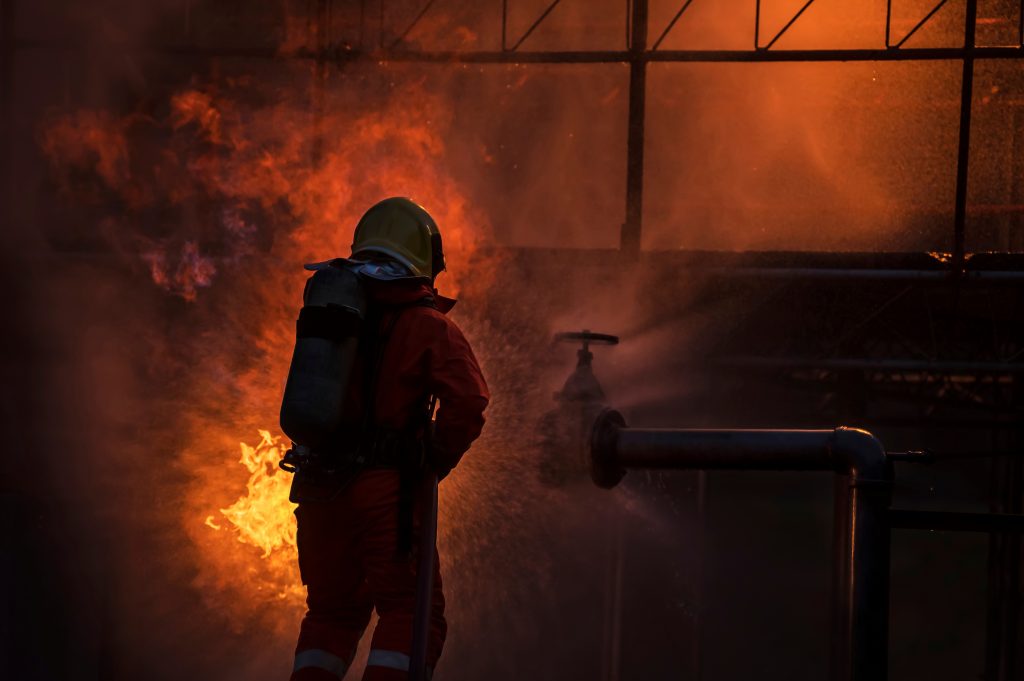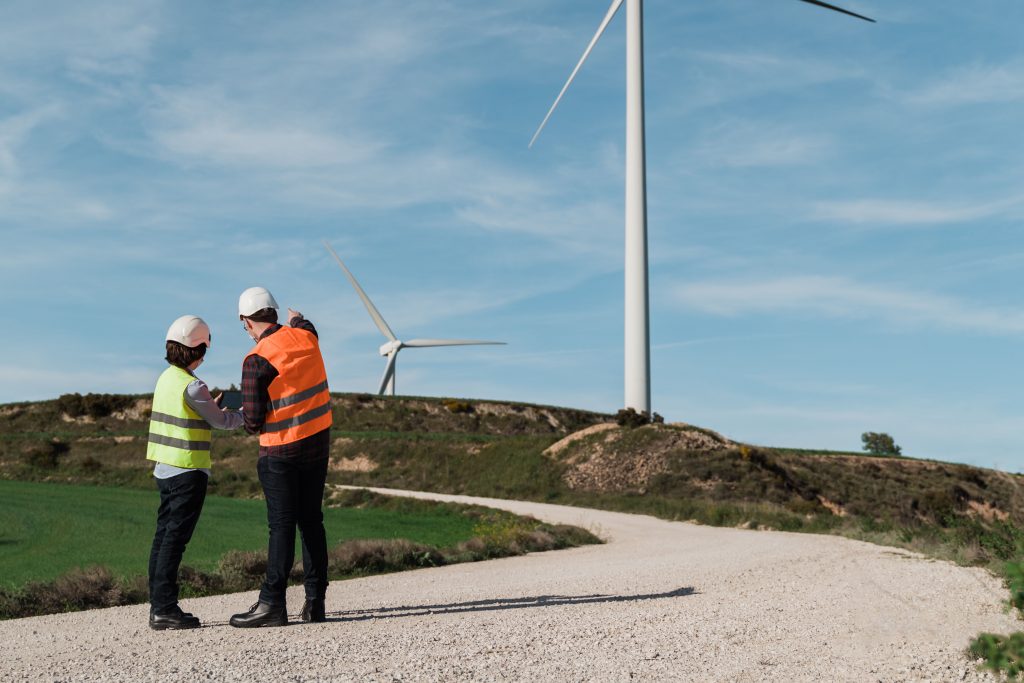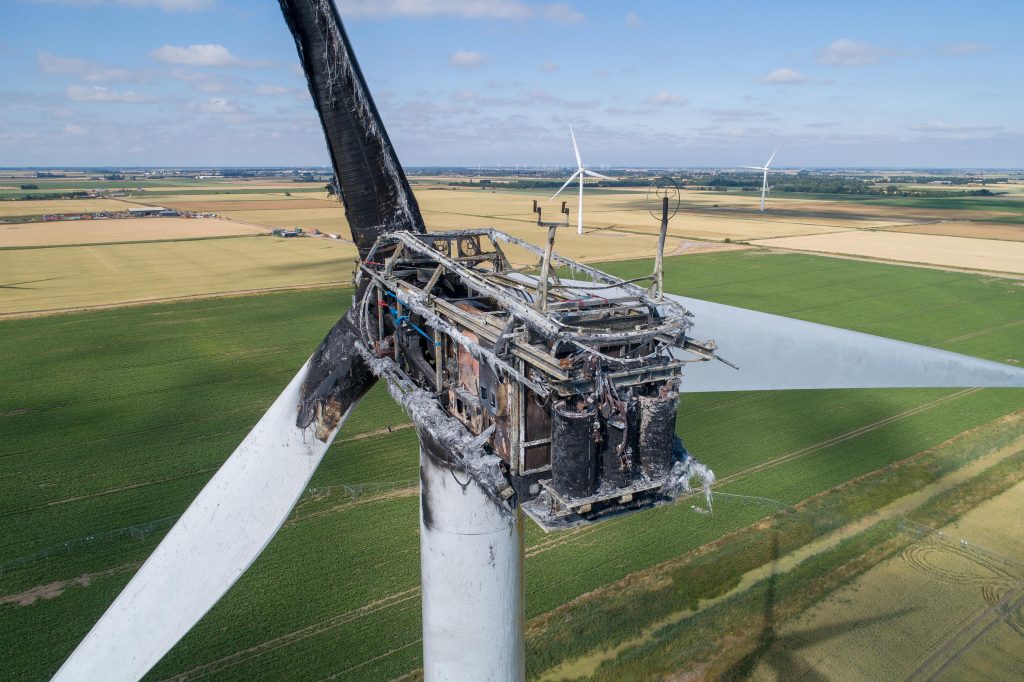Wind turbine fires are relatively rare. But when turbines do catch fire, the ensuing spectacle of rotating flames and falling debris is impossible to ignore.
Less transparent, though, is industry-wide data on details such as how many turbines burn down and the full cost of damages when they do. Most often, these facts are known only to insurers and project owner-operators.
The recent fire to a Vestas V90 2MW turbine at Galgenberg wind farm in southwestern Germany — for which, in the absence of lightning, investigators have so far struggled to identify the cause — brings the wind sector’s lax attitude to controllable risks under the microscope once again.
As this and other recent incidents have shown, once a turbine catches fire, there is little authorities can do but try to secure the area from flaming debris and monitor the flames as they burn themselves out.

Again, this is not an isolated occurrence. Mere days later, a Senvion turbine caught fire at Cullerin Range wind farm in New South Wales with investigations yet to understand the cause. And in late October 2022, a Vestas V110-2.0 turbine caught fire at Diamond Trail wind farm in Iowa County. In this instance, the flames spread to the field below, and several other turbines had to be taken offline for additional inspections to assess the fire risks, which lead to further disruption and lost revenue.
The question that will increasingly be asked of the wind industry, as it continues to grow, is what measures are being taken to avoid preventable losses like these?
While it is true that learning the specific cause of a turbine fire can prove difficult, expensive, and time consuming, understanding how these assets can be protected from this risk, and acting upon this knowledge, is not.
Who is taking responsibility?
The key obstacle to mitigating avoidable risks is the assumption that responsibility falls elsewhere in the supply chain.
The time and financial constraints pressing developers are such that to install fire suppression technology at the manufacturing stage is not a priority, even though it is available. Additionally, project owner-operators tend to assume fire risk has been “designed out.” Experience shows this is not the case; it has merely been passed on to the owner-operators who need to retrofit the appropriate technology to protect their assets.
With owner-operators deferring responsibility of fire-risk management to developers, and vice versa, it is too often the case that risks are not managed at all. The result is an implicit attitude that the insurer will shoulder the costs if a fire indeed occurs. While more insurance capital is flowing into the market, the market is also hardening in response to increased losses. Thus, owner-operators who are seen to be passing the tab onto insurers are at the mercy of underwriters increasing premiums accordingly.
Not only that, but the more the insured lean on insurance to pick up their risks, the greater the possibility that insurers will move to increase deductibles and remove coverage for lost revenue during periods of downtime in order to re-balance underestimated renewable energy risk portfolios. Since the average downtime after a wind-turbine fire is approximately 12-18 months, this could reach up to $1 million per affected turbine.
Legislation also has a role to play in ensuring wind energy assets are adequately protected from fire. At present, there is very little standard legislation that mandates fire-safety precautions specifically for the wind sector.
In places such as Ontario, Canada, where some policies exist to enforce the use of vetted risk protection technologies, this is very much the exception rather than the rule. It is far more often the case that fire-safety features, though recommended, are left to the discretion of the owner-operator. Given that this comes at a cost, albeit less than the rounding error in renewable project budgets, the odds are increasingly stacked against the necessary management of fire risk.
All things considered, the lack of collective responsibility taken by key stakeholders in the wind sector to implement the requisite safety features is concerning, particularly ahead of an expected period of expansive growth.

How can owner-operators take responsibility?
Project owner-operators can play a pivotal role in changing the way in which the industry approaches fire risk management both in existing assets and in future assets.
In the case of the Vestas V90 turbine, the wind-farm operator, Windpark Saar, speculates that an issue with the braking system may have caused the fire. This, and other failures, are unexpected in a model that is only 7 years old. This incident serves as an example of how unpredictable problems can lead to catastrophic fire damage and demonstrates how this risk can only be effectively managed by the installation of a clean-agent fire-suppression technology.
Regardless of age, wind turbines are high-voltage machines that produce a lot of heat and are subjected to harsh weather conditions. Degradation and maintenance needs are to be expected. High-voltage cabinets, transformer rooms, brake and slip rings are all routinely checked for signs of wear, but not all of these parts are protected from fire risk even though they can be easily equipped with the technology.
Currently, the industry focus is on building bigger wind turbines with more capacity – the most recent being a colossal 18 MW wind turbine released in China. However, even as the designs of new turbines increasingly upgrade the power production of the asset, there is no reason for owner-operators to believe their models will be equipped to mitigate risks such as fire. In fact, the only way they can be assured of this with new assets is by requesting that designers incorporate the relevant safety features and factor that into their expenditure.
Precise figures on the likelihood of wind-turbine fire range between 1 in 2,000 to 1 in 7,000 turbines depending on who you ask, but the salient point is this threat exists and affects turbines every year.
As it stands, fire-suppression systems are nearly always retrofitted after a fire incident, rather than proactively ahead of an event. Considering the cost of the lost asset, loss of revenue due to downtime, and the insurance increase per turbine after a fire event, this is equivalent to shutting the stable door after the horse has bolted. And this is before considering the impact of reputational damage and disruption to day-to-day business operations.
And so, the proactive installation of fire-suppression technology, either at the manufacturing stage or as fleet retrofit projects, represents a proactive and cost-effective way for owner-operators to manage their risks and protect themselves against significant potential losses.
Which other industry stakeholders can help drive change?
The loss of an asset to fire has direct implications for insurers. It isn’t just the potential $9 million claim for cleaning up and replacing a damaged turbine, but the business interruption and lost revenue on top of that, which could amount to as much as $2,000 a day.
According to data from GCube, a leading underwriter for renewable projects, insurers have seen a 38 percent increase in business interruption claims since 2016. As the price of premiums rise in response to this, there is a concern that this does more to consolidate, rather than deter, the attitude that the bill for fire damage can just be passed onto the insurer.
A possible middle-ground here would be for insurers to incentivize the retrofitting, or “opt-in” at the manufacturing stage, of fire-suppression systems with decreased premiums or lower deductibles for the project owner-operator to reduce the volume of annual claims related to fire.
With proven and bankable clean-agent fire detection and suppression solutions available in the market, it makes sense for insurers to encourage the insured to take up the option to protect themselves against the worst-case scenario. This is already the case in more mature industries open to fire risk, such as manufacturing and machining, where insurers are offering discounts when sufficient risk-protection technology is proven to be in place.
How governments can take responsibility
Government policy can play a powerful role in a unified industry approach to managing fire risk, too.
In a moment where wind projects are being deployed at a historic rate around the world to meet net-zero targets, governing bodies can ill-afford the reputational damage that comes with wind-turbine fires.
In spite of this, across much of North America, there is no mandate for even so much as a fire-risk assessment for wind-farm owner-operators, let alone fire-suppression systems. And though countries in Europe, such as Germany, have brought in such mandates in recent years, the stipulations of that legislation still leave room for owner-operators to interpret the risks and make their own decisions — as opposed to having legislation that directly dictates the behaviors and actions needed to protect the lives and livelihoods of the technicians and the community.

The wind sector in the U.S. has yet to introduce strict regulation, and it currently abides by the National Fire Protection Association 850 code that applies to all forms of power generation. This offers a set of recommendations but no requirements. As the sector primarily operates on a utility scale, it will only be a matter of time before strong, uniform guidelines surrounding fire risk are required.
What are the consequences of failing to change the industry’s current attitude to fire risk?
According to the research of the International Association for Fire Safety Science (IAFSS), there is stubborn reticence to report wind-turbine fires. Going back to the years between 2006-2010, both The Telegraph and Renewable UK estimated a total of 1,500 wind-turbine fires. This, in contrast to the Caithness Windfarm Information Forum (CWIF) statistic of 142 reported cases in the same period, indicates that roughly 90 percent of cases go unreported.
Not only is this approach unsustainable as more wind projects are commissioned, but it also prevents the industry from understanding the true level of risk fire represents and, as a result of this lack of knowledge, from building the necessary best practice in response.
To ensure we make the most of this period of growth, the wind industry must now demonstrate its sustained commitment to safety. Failure to proactively protect against controllable risks like fire could set us back with the following issues:
- Unsafe work environments for on-site personnel.
- Unnecessary loss of assets to fire – the cost of which is often underestimated.
- Additional strain on already stretched supply chain.
- Increased insurance claims, leading to increased premiums, decreased coverages, and/or insurers leaving the renewables market.
- Increased risk of wildfires in surrounding areas.
- Reputational loss and public criticism of the industry.
What is essential now is that the sector works collectively to own these risks, rather than assuming someone else will take responsibility. Ultimately, project owner-operators need to take the lead and invest in clean-agent fire detection and suppression systems, but, equally, it is incumbent on the other stakeholders to encourage this best practice with incentives and policies.
If all parties work together, the risk of wind-turbine fires and their numerous safety, financial, environment, and reputational consequences will be drastically reduced — if not eliminated.
























